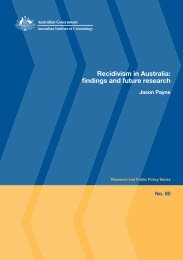Crime and victim surveys - Australian Institute of Criminology
Crime and victim surveys - Australian Institute of Criminology
Crime and victim surveys - Australian Institute of Criminology
Create successful ePaper yourself
Turn your PDF publications into a flip-book with our unique Google optimized e-Paper software.
JAN J.M. VAN DIJK<br />
principles <strong>of</strong> equality <strong>and</strong> consistency (van Dijk 1986; Sumner 1987). A greater<br />
involvement <strong>of</strong> crime <strong>victim</strong>s in criminal proceedings will be more strongly<br />
opposed to the extent that <strong>victim</strong>s are believed to seek gratification <strong>of</strong> personal<br />
emotional needs. In the early days <strong>of</strong> the <strong>victim</strong> movement, some lawyers<br />
favoured state compensation <strong>and</strong> counselling as an alibi for denying crime<br />
<strong>victim</strong>s access to criminal procedure.<br />
Criminologists have for years tried to redress the image <strong>of</strong> the <strong>victim</strong> as a<br />
person who seeks reassurance for his fears by dem<strong>and</strong>ing severe sentences. In<br />
the 1970s survey researchers concluded that fear <strong>of</strong> crime sometimes moved in<br />
the opposite direction to changes in recorded crime. Personal or household<br />
<strong>victim</strong>isations were found to be weakly related to fear <strong>of</strong> crime (Van Dijk 1978,<br />
1979; Rifai 1982). Sparks, Genn <strong>and</strong> Dodd (1977) even speculated that<br />
<strong>victim</strong>isations reduce fear. Those most at risk such as adolescents did not exhibit<br />
most fears <strong>and</strong> those least at risk from ordinary street crime⎯ elderly<br />
ladies⎯ were most fearful (Hough & Mayhew 1983). Those who were fearful did<br />
not themselves try to reduce their perceived risks. On the basis <strong>of</strong> these findings<br />
<strong>and</strong> discrepancies, fear <strong>of</strong> crime was frequently described as ‘irrational’. Fear <strong>of</strong><br />
crime was said to be fuelled by exaggerated media reporting on violent crime <strong>and</strong><br />
exploited by political parties <strong>and</strong> the security industry. It was sometimes also<br />
found to be associated with racist attitudes.<br />
In the reports on the first generation <strong>of</strong> crime <strong>surveys</strong> excessive fear itself<br />
was <strong>of</strong>ten identified as a negative force which undermines the social fabric <strong>of</strong> the<br />
community. Those who take special measures to protect their households against<br />
crime were said to exhibit a ‘fortress mentality’. Rather than acting as a rational<br />
response to crime, fear was construed as a social problem in its own right <strong>and</strong> in<br />
fact a cause <strong>of</strong> crime (Conklin 1975; Skogan & Maxfield 1981; Wilson &<br />
Kelling 1982).<br />
Little empirical support was also found for the ‘fear <strong>of</strong> crime causes<br />
punitivity’ hypothesis. Personal <strong>victim</strong>isations were found to be unrelated to a<br />
preference for severe sentencing (Taylor et al. 1979; Fattah 1979; Tyler & Weber<br />
1982; Brillon 1983). Increased crime rates did not go together with a dem<strong>and</strong> for<br />
more severe punishment in The Netherl<strong>and</strong>s (Van Dijk & Steinmetz 1988).<br />
Opinions on sentencing were related to level <strong>of</strong> education <strong>and</strong> age but not to<br />
<strong>victim</strong>isation (Wanner & Caputo 1987). Punitivity was partly seen as a<br />
consequence <strong>of</strong> media-induced, exaggerated fear. In addition it was supposed to<br />
be determined by political-social ideology (Killias 1989).<br />
In the criminologists’ book, neither fear nor punitivity were seen as natural<br />
responses to rising rates <strong>of</strong> violent crime. The politicians’ equation <strong>of</strong><br />
<strong>victim</strong>isation by crime with feelings <strong>of</strong> fear <strong>and</strong> punitive attitudes was rejected.<br />
Interestingly, criminologists did not only take issue with the image <strong>of</strong> the <strong>victim</strong><br />
as a spontaneous campaigner for law <strong>and</strong> order but even sought to turn the<br />
argument around. They not only denied that <strong>victim</strong>s are fearful <strong>and</strong> punitive but<br />
also construed these very attitudes as socially harmful. The politicians’<br />
exploitation <strong>of</strong> fear as an argument for heavy sentencing was seen as part <strong>of</strong> the<br />
problem rather than <strong>of</strong> the solution (Fattah 1982). In the USA fear reduction was<br />
put forward as an important policy goal, independent <strong>of</strong> crime reduction (Skogan<br />
1981). In Europe the Council <strong>of</strong> Europe set up a committee <strong>of</strong> experts in the mid<br />
122















